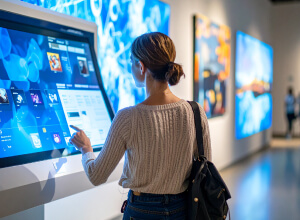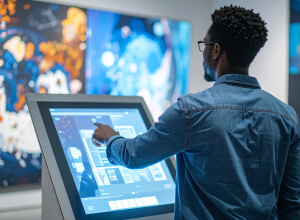Follow Intuiface:
December 15, 2021
InsightLooking Back and Looking Ahead: The 2021/2022 Edition

This is a Guest Blog Post by
Geoff Bessin
CMO
It's time! We share our list of standout developments in 2021 and our forecast expectations for 2022. Huh, we may be geniuses!
Here is our annual look at the year that's past and predictions for the year to come in the world of digital signage. For good measure we've added our 2021 achievements because our arms are just long enough to pat our own backs.
Looking Back at 2021
- Accelerating preference for self-service
Social distancing greased the wheels for getting things done without assistance. From curbside pickup to kiosk-based ordering, staff and shoppers were separated by more than acrylic. The ironic side effect - confounding initial expectations as the pandemic first raged - was to increase touch screen use, contrary to hygiene-aware expectations. - Security, security, security
Thanks to GDPR and similar global policies, anonymity and data security have become table-stakes, demanded by customers with increasingly savvy expectations for how their privacy should be respected. In addition, as signage continues its migration the cloud, the rising incidence of hacked screens and IT infrastructure further reveals the vulnerability of digital signage. A small minority of DS vendors have achieved ISO 27001 and SOC2 certifications but most are black boxes their prospects are asked to trust. - Mainstream adoption stalls for analytics
Partly due to the distraction raised by global events, partly due to an industry that continues to avoid a topic about which it isn't very good - widespread analytics adoption failed to materialize. Although public-facing kiosks are just as data rich as web and mobile deployments, there is no comparison with regard to web/mobile data collection and visualization maturity. Project KPIs for signage deployments are left in the dark for another year. - DS vendor consolidation and verticalization through M&A
Commodity vendors were swept up as a wave of verticalization drove M&A investment. Large integrators with ISV subdivisions are attempting to create their own self-sufficient ecosystems while independent innovators have focused on best-of-breed partnerships. It’s another round of the age-old debate for any industry, verticalization vs. multi-vendor excellence. - Face-to-face meetings with customers and partners failed to materialize
The conference and in-person sales call rebound didn’t happen. Travel bans kept businesses in-country and health concerns argued against busy trade show floors. Events did happen but only sporadically and with far fewer attendees than in pre-COVID years. The hunger for face-to-face is as strong as ever but must wait another year.

Notable Intuiface Achievements in 2021
- Launch of Intuiface 7
More than a year in the making (thanks for the delay, COVID!), Intuiface 7 introduced the world to Player Next Gen, an innovative Headless CMS, and a brand new licensing and packaging model that simplified adoption and increased feature access. We are quite confident that these significant evolutions to the Intuiface platform set us up perfectly for the coming year. (See our predictions below.) - Intuiface Leadership Summit
Extreme social distancing couldn't put a damper on our desire to meet with the leaders among our users to discuss the challenges and rewards of running an Intuiface-based business. (Particularly relevant as some platform alternatives were swept up in the M&A spree mentioned above for 2021.) We hosted a virtual event and were joined by more than 100 attendees. Guest speakers and Intuiface experts covered a variety of topics including how to market interactivity, use of Intuiface as a pre-sales tool, and how to turn analytics into a billable service. Videos of all sessions can be found online. - Digital Interactivity Landscape
Intuiface joined forces with invidis - a Europe-based boutique consultancy specialized in digital signage - to produce the Digital Signage and DooH industry's first-ever exhaustive list of interactive technology suppliers. Designed for use by enterprises as well as agencies and integrators, this free poster dramatically simplifies the effort to identify and research the more than 130+ hardware and software vendors enabling real-time interaction with on-premises digital content. Certainly a great way to overcome at least a tiny bit of the face-to-face vacuum that occurred this year. - Samsung Kiosk Partnership
Intuiface was introduced by Samsung as one of just a handful of partner companies for the launch of their Tizen-based Kiosk, an all-in-one kiosk with integrated peripherals, simple set-up, antibacterial coated-screen, and low TCO. Intuiface represents the only no-code approach to app creation for the Kiosk and has run 10+ briefings since July for both global Samsung sales teams as well as their integrator and assorted other channel partners. We're thrilled because this fits in perfectly with the drive towards more and more self-service that has characterized 2021. - ISO 27001 recertification
Proactively concerned about information security - reinforced by 2021 developments as outlined above - Intuiface was the first company in the Digital Signage space to achieve ISO 27001 certification. Accomplished in 2020, this certification requires annual assessments to ensure our execution matched our plan and to identify the need for process addition or modification. Intuiface passed its assessment and achieved recertification. As of mid-December 2022, Intuiface is one of only three signage CMS companies that has received this certification.

Looking Ahead at 2022
- Low code / no code goes mainstream
Low code / no code will become a must-have for the digital signage community, reflecting the broader move to no-code across industries. The citizen developer will become more prominent than ever, coaxed further into the light as the acceleration of digital-based engagement continues to outpace the supply of skilled resources. It’s the democratization of both business processes and creative exercises, empowering those with expertise about the customer (perhaps the knowledge worker him/herself!) to overcome their lack of expertise about coding. Time-to-market trumps not-invented-here; speed and agility surpass slow and steady. Legacy vendors embrace (and encode) the paradigm or risk losing to the innovators. - Green computing moves past ambition
Be it ecological or financial, incentives abound for the embrace of sustainable computing. Low power and high performance - aka doing more with less - will transition from ambition to expectation, and the extended shelf-life of existing hardware - keeping them out of our landfills - will be talking points during earnings reports. The sluggish microchip supply chain is the final nail in the coffin of wasteful behavior. - Rising need for DXP approach to signage
The 2021 DIY spirit in shoppers, with associated use of in-venue tech to facilitate everything from self-search to self-purchase, necessitates treatment of that place-based digital content as a first-class citizen, on par with web, mobile and social media investment. Add to this the hunger for data-based insight, which will continue to grease the wheels for in-venue analytics adoption. Retailers will be driven to connect signage- and kiosk-based content with the communication and data collection tech reaching consumers at home and on their personal devices thanks to Digital Experience Platforms (DXPs). - Signage extends to the web for personal device use
The constant-on usage of personal devices will push content providers and innovators to find avenues for merging in-venue digital and mobile phones. The technical facilitator here is movement of both broadcast and interactive signage content to the web. Expect to see three key use cases: driving audiences to a venue, providing audiences with takeaways from a venue, and hybridizing in-venue experiences via real-time interaction between a device and place-based content. This is how modern venues will differentiate themselves from the mainstream. - Fragmentation of marketplace despite verticalization of vendors
The M&A surge towards verticalization creates one-stop shops promising total project delivery competency, from hardware to services to software. These integrators will grapple with the tension between selling service hours vs. higher and higher R&D investment in technical innovation, simplification, and security. The resulting resistance to partnerships and a drive for billable hours creates counter-pressure on moving technology forward. Meanwhile, some ISVs will pursue project and service delivery, pivoting from listening to the market to listening to a small pool of paying customers. A dedication to innovation for the rest of the ISVs will bring novelty to the marketplace but risk marginalization. Across the board, enterprise clients will encounter a variety of signage-delivery business models and will benefit from guidance for which approach best fits their current and future needs.






